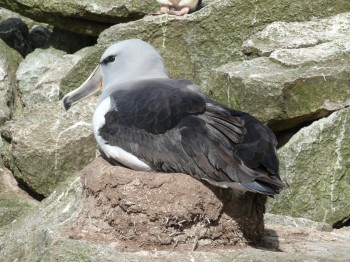New Zealand operates a domestic Threat Classification System for its indigenous taxa, including birds. A report by Hugh Robertson and colleagues on the conservation status of New Zealand birds for 2012 has recently been released by the Department of Conservation, reflecting the changing fortunes of a number of species, including several ACAP-listed albatrosses.
According to the New Zealand Threat Classification System Manual three categories of threat are used: Nationally Critical, Nationally Endangered and Nationally Vulnerable.
Edited extracts from the report’s summary dealing with procellariiform seabirds whose categories have changed since a previous review in 2008 follow (ACAP-listed species are in bold).
The status of three procellariiform taxa worsened and they were shifted into the Nationally Critical category (the most threatened): Antipodean Albatross Diomedea antipodensis antipodensis, Gibson’s Albatross Diomedea a. gibsoni and Salvin’s Albatross Thalassarche salvini. In contrast the Grey-headed Albatross T. chrysostoma has been moved to Nationally Vulnerable due to its improved situation.
The New Zealand Storm Petrel Pealeornis maoriana was moved from the Data Deficient category to Nationally Endangered following the discovery of its breeding locality and more information on its likely population size. The North Island Little Shearwater Puffinus assimilis haurakiensis improved from Relict to the At Risk - Recovering Category.
Three procellariiform taxa were added to threatened categories for the first time: Antipodean Albatross, Flesh-footed Shearwater Puffinus carneipes (to Nationally Vulnerable) and the New Zealand Storm Petrel. The shearwater has previously been identified as a potential candidate for ACAP listing.

Salvin's Albatross on the Snares: now deemed Nationally Critical
Photograph by Paul Sagar
With thanks to Barry Baker for information.
References:
Miskelly, C.M., Dowding, J.E., Elliott, G.P., Hitchmough, R.A., Powlesland, R.G., Robertson, H.A., Sagar, P.M., Scofield, R.P. & Taylor, G.A. 2008. Conservation status of New Zealand birds, 2008. Notornis 55: 117-135.
Robertson, H.A., Dowding, J.E., Elliott, G.P., Hitchmough, R.A., Miskelly, C.M., O’Donnell, C.F.J., Powlesland, R.G., Sagar, P.M., Scofield, P. & Taylor, G.A. 2013. Conservation Status of New Zealand Birds, 2012. New Zealand Threat Classification Series No. 4. Wellington: New Zealand Department of Conservation. 22 pp.
Townsend, A.J., de Lange, P.J., Duffy, C.A.J., Miskelly, C.M., Molloy, J. & Norton, D.A. 2008. New Zealand Threat Classification System Manual. Wellington: New Zealand Department of Conservation. 35 pp.
John Cooper, ACAP Information Officer, 17 November 2013

 English
English  Français
Français  Español
Español